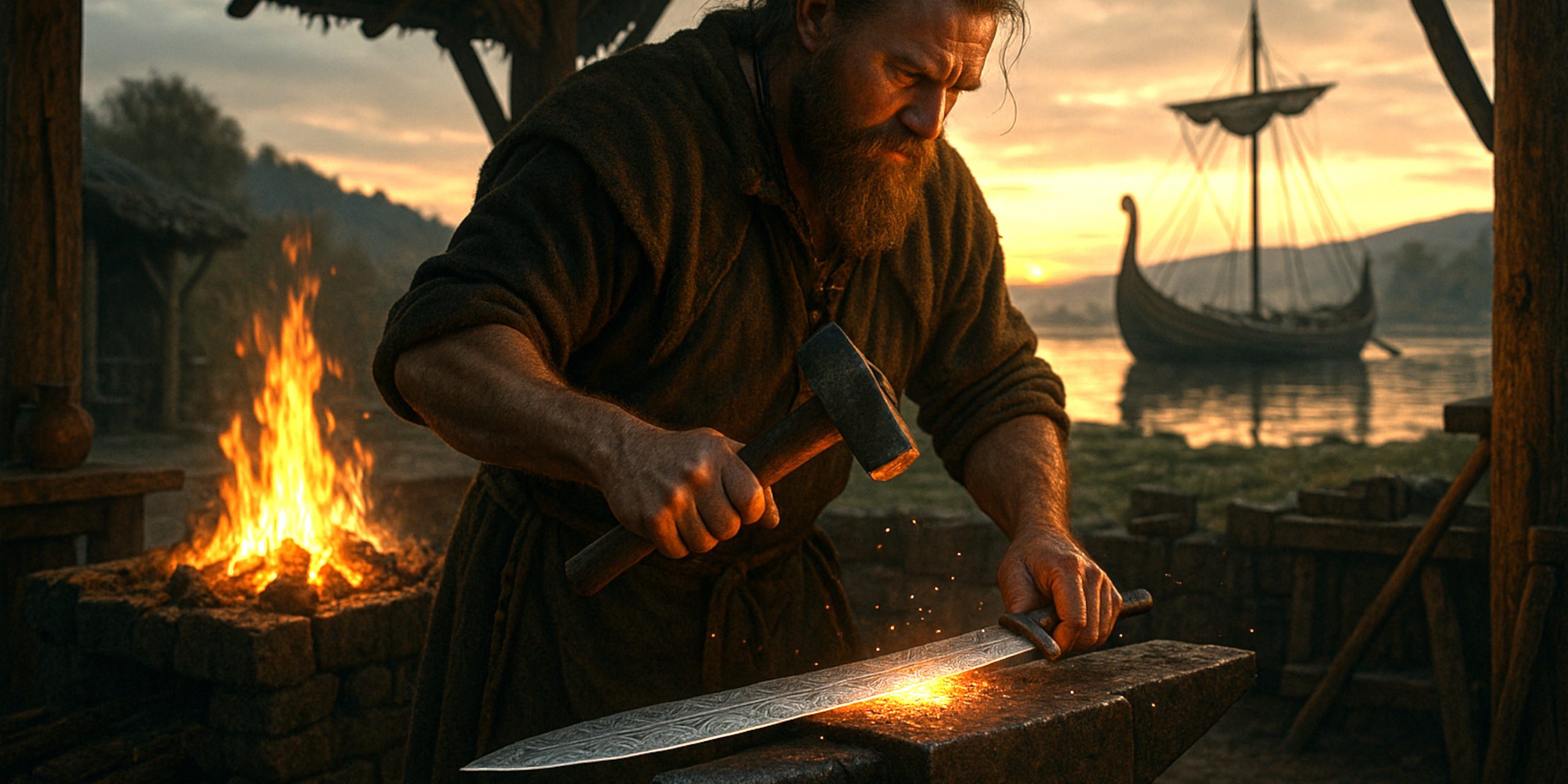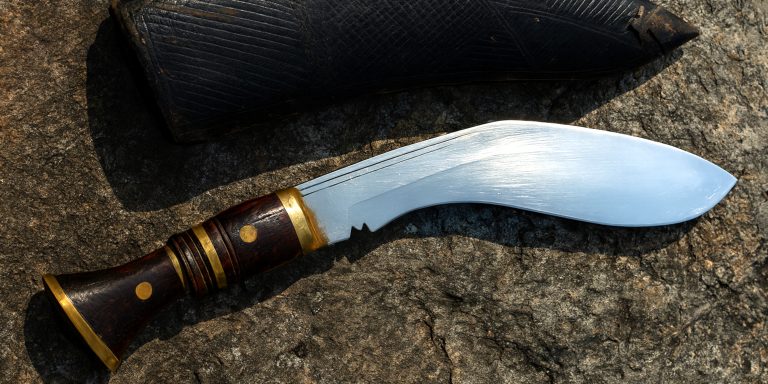
Pattern welding is one of those terms that sounds oddly modern, as if it belongs in a factory catalogue or a blacksmith’s online shop. Yet, it is one of the oldest and most mesmerising techniques in sword-making history. These blades shimmer with layered ripples of steel, almost like wood grain, a deliberate effect created by welding together strips of iron and steel. To the untrained eye, it might seem decorative, but in the ancient world, those swirling patterns were as much about strength as they were about style.
For centuries, the pattern welded sword was the mark of a craftsman’s pride and a warrior’s prestige. To hold one was to wield both beauty and blood in the same breath.
The History of Pattern Welding
The story begins in the early Iron Age, around the 3rd century BC, when smiths faced a problem. Iron was plentiful, but its quality was wildly inconsistent. Some batches were soft and brittle, others too hard and liable to crack. The answer was ingenious: layer different types of iron and steel, heat them until they nearly melted, and hammer them together. The process created a single, stronger piece with a balance of flexibility and hardness.
By the Roman period, pattern welding was an established art. Roman spathae (long cavalry swords) and early migration-era blades often reveal intricate twisting patterns in cross-section, like the woven strands of a rope frozen in steel. The Germanic tribes, too, adopted the technique, and by the time of the Vikings, it had become a hallmark of northern swordsmithing.
One of the most famous finds is the so-called Ulfberht sword, many of which display the rich surface texture typical of pattern welded blades. Etched or polished, these patterns were both functional and a kind of calling card for their makers.
The Technique and Its Secrets
At its core, pattern welding involves:
- Layering strips of iron and steel.
- Heating them to near-fusion temperature.
- Hammering and folding to combine them.
- Twisting and grinding to reveal patterns once polished.
The result was not only a stronger blade but one with a mesmerising surface that caught the light like flowing water. Each smith had their own methods and preferred motifs, ranging from ladder and herringbone to chevron and serpent designs.
As steel production improved in the later Middle Ages, particularly with the advent of crucible steels, the need for pattern welding diminished. True pattern welding declined, only to be revived centuries later by modern bladesmiths who fell in love with its hypnotic patterns and archaic mystique.
Weapons Forged in Pattern
Pattern welding was used primarily for swords, but also for:
- Spears and seaxes, particularly in Anglo-Saxon England.
- Daggers, such as the early scramasax type.
- Axeblades, especially ceremonial or high-status ones.
While weapons were the main focus, the technique was occasionally applied to armour fittings or knife blades, particularly those intended for display or burial.
The Vikings, Franks, and Anglo-Saxons all favoured such weapons for their combination of durability and beauty. A warrior’s sword was not merely a tool but a companion, and a pattern welded blade shimmered as if alive.
Contemporary Voices
We have no written instructions from the smiths themselves, but the sagas and poetry of the early medieval world echo their craftsmanship. In Beowulf, the poet describes a sword “patterned with dark lines, forged with the serpent’s form.” In Old Norse, a pattern welded sword might be called a málmr, meaning both metal and treasure, a word that captures how these weapons straddled utility and glory.
Medieval chroniclers wrote of “blades that shone like woven silver” or “serpent-twined edges.” Even centuries later, chroniclers in the Renaissance admired them as relics of a lost art.
Battles, Treasure, and Fate
Pattern welded swords saw their fair share of blood and legend. From Roman outposts along the Rhine to Viking raids across the North Sea, these blades shaped early European warfare. Many were buried with their owners, destined to rest in ship burials like Sutton Hoo or under mounds in Scandinavia. Others were looted, reforged, or melted down for new wars.
Some blades became literal treasure. Archaeological finds in hoards across Europe show that high-quality swords were traded like currency, their craftsmanship as valued as gold. To a chieftain, gifting a patterned sword was a political statement, a sign of favour or alliance.
As for their fate, most were lost to time and rust. Yet every so often, one surfaces from a riverbed or burial mound, still bearing its distinctive ripples of steel, as if whispering that perfection once had texture.
Legacy and Modern Revival
Modern smiths have resurrected pattern welding, often under the name Damascus steel (though technically different). Today, pattern welded knives and swords are admired for their artistry, even if modern metallurgy no longer requires such methods for strength.
Collectors, archaeologists, and experimental blacksmiths continue to study ancient blades to understand how early craftsmen achieved such precision without modern tools. In the museums of London, Oslo, and Berlin, these relics gleam under controlled light, their patterns as hypnotic as ever.
Where to See Pattern Welded Swords Today
- British Museum, London – Anglo-Saxon and Roman blades.
- National Museum of Denmark, Copenhagen – Viking swords with intricate pattern work.
- Germanisches Nationalmuseum, Nuremberg – Migration period examples.
- Museum of Cultural History, Oslo – A rich collection of Norse and Viking weapons.
For those fascinated by technique, many experimental archaeologists and blacksmiths host demonstrations of pattern welding at living history events across Europe. It is oddly thrilling to watch a forge glow orange while a craftsman layers and twists the steel, recreating a 1,500-year-old dance of fire and hammer.
Seven Swords Takeaway
Pattern welded swords are a rare intersection of art and survival, beauty and brutality. They remind us that even in war, there was room for artistry, and that technology often begins not in laboratories but in the flickering light of a forge.
As a historian, I have always admired how the ancients solved problems through ingenuity rather than resources. Pattern welding was born not from luxury, but necessity. Yet the result was something more than practical, something that turned the act of killing into a statement of craftsmanship. There’s something both unsettling and profoundly human about that.
Watch the documentary:



